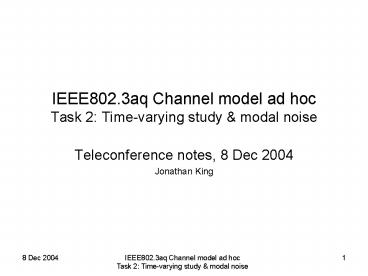IEEE802'3aq Channel model ad hoc Task 2: Timevarying study PowerPoint PPT Presentation
Title: IEEE802'3aq Channel model ad hoc Task 2: Timevarying study
1
IEEE802.3aq Channel model ad hocTask 2
Time-varying study modal noise
- Teleconference notes, 8 Dec 2004
- Jonathan King
2
Agenda
- Attendees
- Agree last meetings minutes
- Task 2
- no agenda items
- Launch study, joint task 2 task 4
- Joerg Kropp - OM3 simulations and experiment
- David Cunningham - PIE-D measurements on OM3
fibres - other business
- next meeting date/time
3
1) Attendees
- Jonathan King, Big Bear Networks
- Yu Sun, Optium
- John Jaeger, Big Bear Networks
- Joerg Kropp, Infinion
- David Cunningham, Agilent
- Sudeep Bhoja, Big Bear Networks
- John Ewen, JDSU
- John Abbott, Corning
- Jim Morris, DOC
- Al Brunsting, Panduit
- Andre van Schyndel, Bookham
- Jonathan Ingham, Cambridge
- Pete Hallemeier, Optium
- Lew Aronson, Finisar
4
2) Agree last meetings minutes
- Peter Hallemeier and Joerg Kropp asked to be
added to the attendee list no other comments
3) Task 2 - no agenda items
5
4) Launch study, joint activity task 2 4 - 1
a) OM3 simulations and experiment - Joerg Kropp
Modeled OM3 DMD and bandwidths were compared
with measurements on 3 recently made OM3 fibres
for CL and OSL (connector offsets were not
included in calculations). An alpha-p fit of 2.09
was derived by comparing modeling and
experimental results. Calculations showed that a
good single mode spot launched into ideal OM3
resulted in good transmission for both CL and
OSL, but if a wider core area was excited, OSL
bandwidth collapsed and CL gave best
transmission. Experiments showed significantly
better transmission for CL. Discussion
following John Abbott noted that the typical
alpha-p value wouldn't necessarily reflect worst
case fibres. Joerg Kropp commented that he
thought that OSL would be challenging in the
presence of connector offsets.
b) PIE-D measurements on OM3 fibres - David
Cunningham Presented measurements of PIE-D
metrics on recently made 300m OM3 fibres for CL
and OSL (with and without 7um MM-MM connector
offsets included). Results showed that single
mode CL was lowest PIE-D both with and without
connector offsets. It was also noted that an
ROFL launch (also a centre launch) gave
significantly higher PIE-D values than single
mode CL. It was noted that OM3 fibre
characteristics were fairly consistent fibre to
fibre, so these results were expected to be
representative of modern OM3 fibres.
6
4) Task 2 4 joint activity on launch study - 2
a) PIE-D measurements on OM3 fibres - David
Cunningham Discussion following The possibility
of a high offset launch was discussed, David
Cunningham said that although PIE-D metrics
peaked at 10-12um, higher offset OSL gt17um would
introduce significant mode selective loss and
modal noise issues. Joerg Kropp commented that
an OSL on OM3 would be challenging in the
presence of connector offsets. Al Brunsting
offered to present measured data on significant
sample sizes of commercial connectors at the next
meeting John Jaeger offered further measurements
on OM3 fibres for 15th Dec. There was some
discussion on launch compliance tests. There was
some support for appropriate encircled flux type
specifications for CL and OSL. CPR (Coupled
Power Ratio) measurement was also discussed for
direct centre launch into MMF, as a test to
ensure a single mode launch at the transponder
was compatible with a mode conditioning
patchcord. Other Discussion points OM2 fibre
model - a task 1 meeting is scheduled for 16th
December next week It was agreed that Jonathan
King should draft up launch and launch compliance
test templates for each fibre type, including a
line for a common launch for all fibre types to
help structure the range of launch selections and
recommendations by this study group
7
4) Other business - no issues raised
5) Next meeting
- Wednesday 15th December 2004 9.30am PCT

